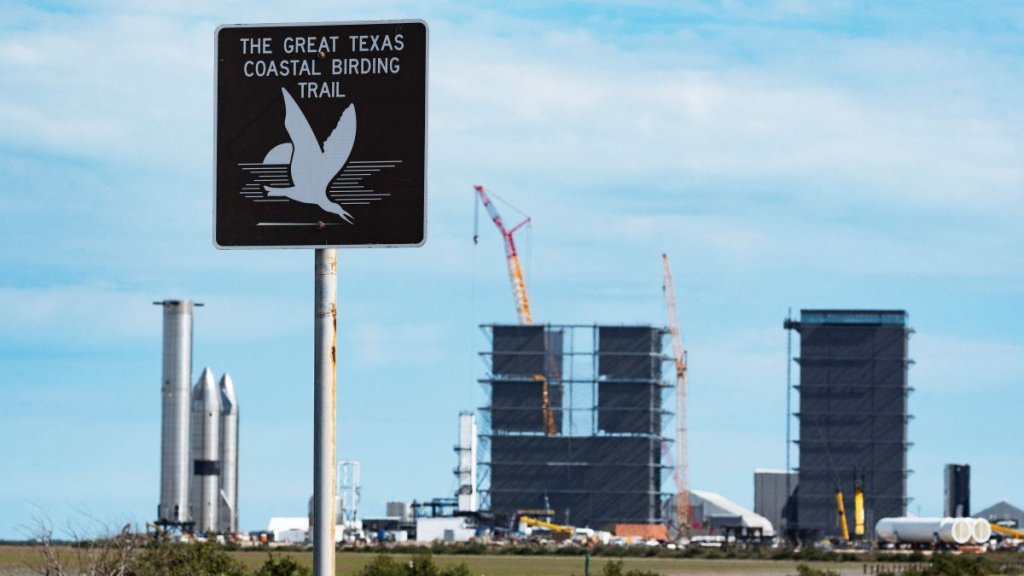
SpaceX Starship launch could harm South Texas birds, advocacy group says (Image Credit: Space.com)
Update for 7:20 p.m. ET on April 17: On Monday evening (April 17), SpaceX announced (opens in new tab) it is now targeting Thursday (April 20) for the next Starship space launch attempt. The launch window opens at 9:28 a.m. EDT (1328 GMT) and closes at 10:30 a.m. EDT (1430 GMT).
SpaceX should move its Starship launch activities from southern Texas to coastal Florida to minimize hurt on bird populations, the American Bird Conservancy says.
SpaceX scrubbed the debut orbital launch of its giant Starship spacecraft on Monday (April 17) following a fueling issue; no new launch date is set yet. It does have a license from the Federal Aviation Administration (FAA) to reach space at some point from Starbase, which is what SpaceX calls its Boca Chica test and launching area.
The American Bird Conservancy, citing declining population levels of the piping plover (a small migratory bird that lives near shorelines) in addition to impacts on other local species, is asking SpaceX to move its Starship work from Boca Chica, Texas to its existing Space Launch Complex 40 pad at Cape Canaveral, Florida. (SpaceX has not commented publicly on this.)
“SpaceX operations continue to damage important coastal bird habitats,” Mike Parr, president of the conservancy, said in an April 14 statement (opens in new tab). “We believe that Cape Canaveral offers a much lower environmental impact option, and is underutilized with less than one launch per month currently despite having six active launch pads — and more pads that could be made available.”
Related: SpaceX’s 1st Starship and Super Heavy launch: How it will work
SpaceX broke ground at Boca Chica in 2014. Infrastructure at Starbase ramped up considerably after 2018, according to Texas Monthly, which lists facilities (opens in new tab) including a solar farm, an RV park, storage facilities and of course, launch pads. Test flights for a SpaceX test vehicle called Starhopper were conducted in 2019, followed by Starship testing on the ground and in flight.
The Boca Chica area, however, is also a popular site for shorebirds (opens in new tab) — including protected species, according to Texas Parks and Wildlife. As such, the FAA conducted a programmatic environmental assessment (PEA) for the Boca Chica area between 2021 and 2022 to examine the ecosystem and Starship’s activities upon it.
The assessment, completed on June 13, 2022, generated 75 action items for SpaceX to address. Then on April 14, 2023, the FAA granted the license, indicating that SpaceX had fulfilled the requirements.

The PEA identified 312 terrestrial species in need of conservation in the study area, including 54 bird species, according to FAA documentation (opens in new tab) from June 2022. The documentation shows that lighting, construction and other human activities will be disruptive to species in the immediate region, although some can move away.
That said, the sparrow-sized piping plover shorebird and the red knot sandpiper are among the species that will be affected, along with their “critical habitat,” the FAA states. Starship was forecast to affect roughly 11 acres of piping plover critical habitat and 23.2 acres of red knot habitat. Yet this territory is only “a small percentage” of the nearby land available to the birds, according to the PEA.
Meanwhile, a 2021 analysis (opens in new tab) of the piping plover population (following individuals marked with tags) suggests the winter population fell 54 percent between 2018 and 2021, from 308 individuals to 142 individuals. That decline is what worries the American Bird Conservancy, which attributes the problem (opens in new tab) to SpaceX and human disturbance. There are subtleties to the figure, however.
The Texan non-profit Coastal Bend Bays & Estuaries Program, which performed the 2021 analysis, suggests the birds may have wintered elsewhere, for example. The analysis does not single out SpaceX as the cause, either.
The overall Northern Great Plains population of piping plovers, estimated at 4,700 individuals in a 2012 peer-reviewed study (opens in new tab), also appears to be steady or in just slight decline. That said, the worry among the conservancy groups is overall numbers could be affected by even small population drops at Boca Chica.
While SpaceX rarely comments on regulatory matters, Musk issued a tweet of support (opens in new tab) in 2021 praising “the hard work by FAA, US Fish & Wildlife and Texas Parks & Wildlife” during the environmental assessment at Starbase.
Elizabeth Howell is the co-author of “Why Am I Taller (opens in new tab)?” (ECW Press, 2022; with Canadian astronaut Dave Williams), a book about space medicine. Follow her on Twitter @howellspace (opens in new tab). Follow us on Twitter @Spacedotcom (opens in new tab) or Facebook (opens in new tab).








